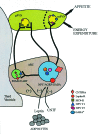Circumventing leptin resistance for weight control
- PMID: 11296275
- PMCID: PMC33319
- DOI: 10.1073/pnas.091101498
Circumventing leptin resistance for weight control
Figures

Comment on
-
Ciliary neurotrophic factor activates leptin-like pathways and reduces body fat, without cachexia or rebound weight gain, even in leptin-resistant obesity.Proc Natl Acad Sci U S A. 2001 Apr 10;98(8):4652-7. doi: 10.1073/pnas.061034298. Epub 2001 Mar 20. Proc Natl Acad Sci U S A. 2001. PMID: 11259650 Free PMC article.
Similar articles
-
Ciliary neurotrophic factor restores gallbladder contractility in leptin-resistant obese diabetic mice.J Surg Res. 2006 Jan;130(1):146-51. doi: 10.1016/j.jss.2005.07.032. J Surg Res. 2006. PMID: 16389100
-
Long-term control of food intake and body weight by hydrodynamics-based delivery of plasmid DNA encoding leptin or CNTF.J Gene Med. 2003 Nov;5(11):977-83. doi: 10.1002/jgm.433. J Gene Med. 2003. PMID: 14601135
-
Overcoming insulin resistance with ciliary neurotrophic factor.Handb Exp Pharmacol. 2011;(203):179-99. doi: 10.1007/978-3-642-17214-4_9. Handb Exp Pharmacol. 2011. PMID: 21484573 Review.
-
Impaired transport of leptin across the blood-brain barrier in obesity is acquired and reversible.Am J Physiol Endocrinol Metab. 2003 Jul;285(1):E10-5. doi: 10.1152/ajpendo.00468.2002. Epub 2003 Mar 4. Am J Physiol Endocrinol Metab. 2003. PMID: 12618361
-
Leptin resistance - or why leptin fails to work in obesity.Exp Clin Endocrinol Diabetes. 2003 Feb;111(1):2-7. doi: 10.1055/s-2003-37492. Exp Clin Endocrinol Diabetes. 2003. PMID: 12605342 Review.
Cited by
-
Leptin and Leptin receptor polymorphisms, plasma Leptin levels and obesity in Tunisian volunteers.Int J Exp Pathol. 2018 Jun;99(3):121-130. doi: 10.1111/iep.12271. Epub 2018 Jun 11. Int J Exp Pathol. 2018. PMID: 29893028 Free PMC article.
-
The Role of Leptin in the Development of Energy Homeostatic Systems and the Maintenance of Body Weight.Front Physiol. 2021 Dec 10;12:789519. doi: 10.3389/fphys.2021.789519. eCollection 2021. Front Physiol. 2021. PMID: 34955895 Free PMC article. Review.
-
The amino acid exchange R28E in ciliary neurotrophic factor (CNTF) abrogates interleukin-6 receptor-dependent but retains CNTF receptor-dependent signaling via glycoprotein 130 (gp130)/leukemia inhibitory factor receptor (LIFR).J Biol Chem. 2014 Jun 27;289(26):18442-50. doi: 10.1074/jbc.M114.568857. Epub 2014 May 6. J Biol Chem. 2014. PMID: 24802752 Free PMC article.
-
Photoperiod regulates leptin sensitivity in field voles, Microtus agrestis.J Comp Physiol B. 2006 Feb;176(2):153-63. doi: 10.1007/s00360-005-0037-8. Epub 2005 Oct 27. J Comp Physiol B. 2006. PMID: 16402185
-
Leptin as a predictor of metabolic syndrome in prepubertal children.Arch Endocrinol Metab. 2017 Jan-Feb;61(1):7-13. doi: 10.1590/2359-3997000000199. Epub 2016 Sep 5. Arch Endocrinol Metab. 2017. PMID: 27598976 Free PMC article.
References
-
- Kalra S P, Dube M G, Pu S, Xu B, Horvath T L, Kalra P S. Endocr Rev. 1999;20:68–100. - PubMed
-
- Friedman J M, Halaas J L. Nature (London) 1998;395:763–770. - PubMed
-
- Heymsfield S B, Greenberg A S, Fujioka K, Dixon R M, Kushner R, Hunt T, Lubina J A, Patane J, Self B, Hunt P, et al. J Am Med Assoc. 1999;282:1568–1575. - PubMed
-
- Mokdad A H, Serdula M K, Dietz W H, Bowman B A, Marks J S, Koplan J P. J Am Med Assoc. 1999;282:1519–1522. - PubMed
-
- Plata-Salaman C R. Semin Oncol. 1998;25:64–72. - PubMed
Publication types
MeSH terms
Substances
LinkOut - more resources
Full Text Sources
Other Literature Sources
Medical

